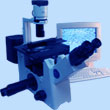
Methods of Investigation
for FP7 partners
and coordinators
|
|||
| Home | |||
| Cytotechnology Group | |||
| Staff | |||
| Methods | |||
| Projects | |||
| Research Results | |||
| Patents | |||
| Image Gallery | |||
| Cooperation | |||
| Contact Us | |||
Approaches to Create Semi-Permeable Transplantable Device |
|
Using imbibition of macroporous polyacrylamide with aminoacids, as well as combined system of alginate and collagen, we, together with our colleagues from the Institute of Bioorganic Chemistry and the Institute of Physics, have developed a new type of cells carrier (Patent BY 8699 C1). This allowed proper immobilization and proliferation of cells without a significant decrease in their viability, which was previously observed mainly due to cell clamping. We align cells using gradient electromagnetic fields (see in detail) and then tested viability of cells in 2 weeks after the immobilization. The cells viability was found to be preserved, and the development of the satellite fibroblast-like elements was negligible. A reliable increase (31.6 ± 9.7%) in amount of hepatocytes was observed, their viability being 97-98%. There were neither annexin-positive no CD-95-positive cells. To analyze the possibility of development and cooperation of cells inside the implant, we tested implantation plates made of materials, which offer both cells protection and support. We used acrylamide and alginate to coat the transplanted cells, as these materials were found to be bio-inert in experiments with animals. To form the inner layer, which contains growing cells, collagen and 7% of agarose were tested. We also took into account adhesion possibilities and marginal thickness of material to provide adequate trophic conditions. Besides, we tested new modifications of acrylamide to produce anti-fibroblast and immuno-isolating coating of plate. Polyamide was used to produce the frame of implantation plate.
More than 30 fragments of implantation plates have been investigated. We performed 107 tests of cell viability using Annexin kit. As much as 16 cultures of cells from fetal porcine pancreas and liver were studied. The results obtained suggest that cells inside laminar containers, which were preliminarily affected with different physicochemical factors to stabilize alignment of cells, preserve high level of viability. Conclusions.
Journal of Clinical Investigation (in press) |
| COOPERATION NEWS | ||
FP7 Programme involves subjects
|
||
| CURRENT RESEARCH | ||
|
||
| 2005-2007 © LBMI |



